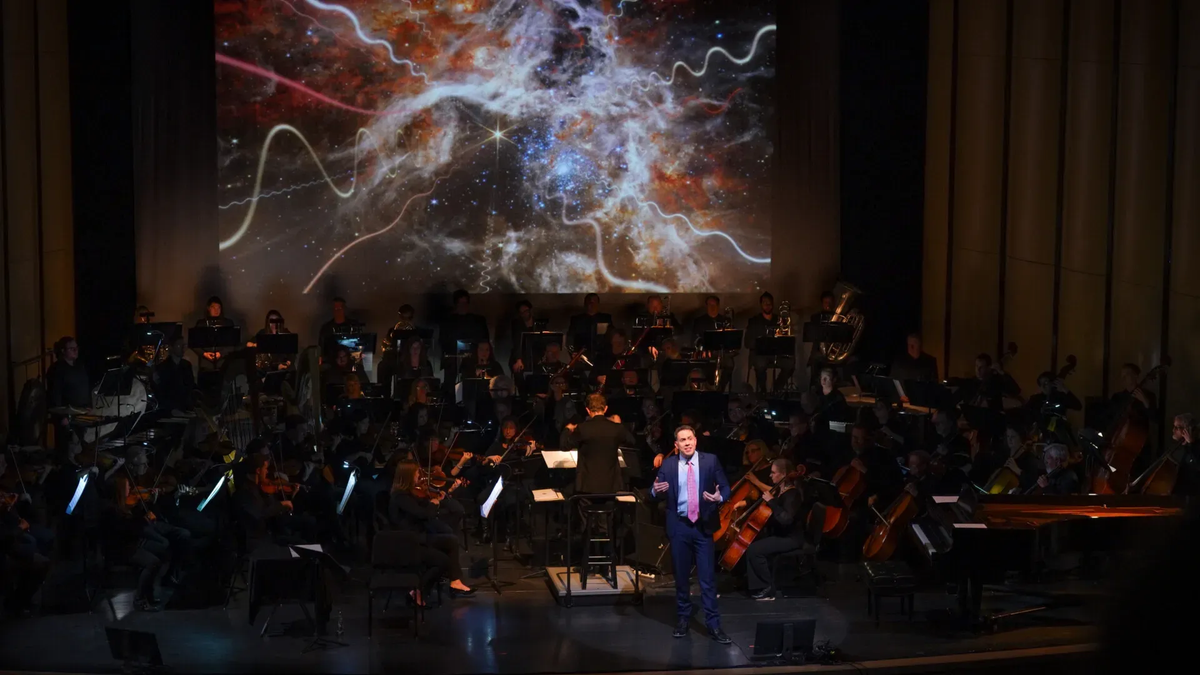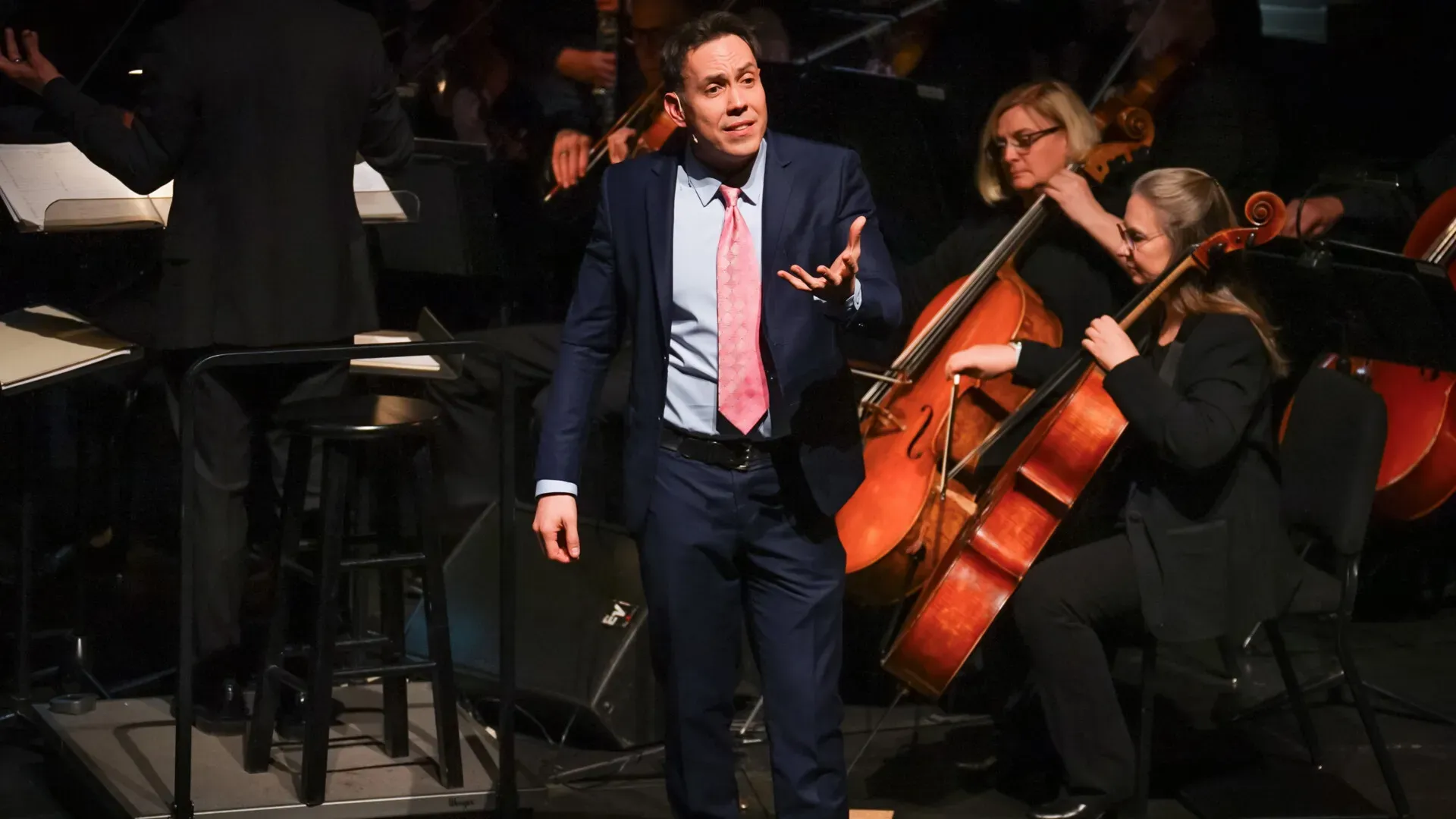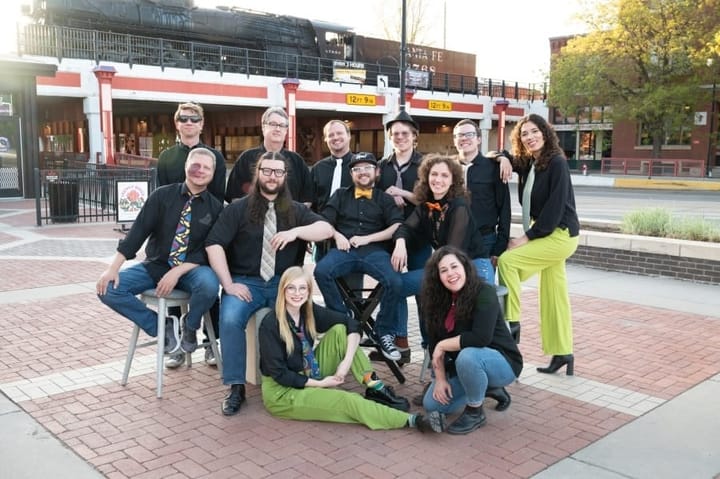Wichita Symphony asks a big question with ‘What Music Is’
The WSO stages a new concert-theater piece that combines astronomy, neuroscience, and symphonic sound on Sunday, November 16.

On Sunday, November 16, the Wichita Symphony Orchestra is turning Century II Concert Hall into a kind of cosmic laboratory.
“What Music Is,” an 80-minute concert-theater piece created by composer, director, and actor Bill Barclay, sets out to explore a deep question: Why does every human culture that’s ever been documented have music? With a full orchestra onstage, live narration, and a giant LED screen suspended over the players, the show pulls together astronomy, neuroscience, and symphonic sound to suggest an answer.
Barclay has spent the past two decades lecturing on the physics of music — “music of the spheres” — across North America and Europe. The project began, he said, when he went looking for a book that didn’t exist.
“I kept expecting to find the book that made it all make sense, and the book wasn’t out there,” he explained in an interview on Friday. “There were mystical writings, and jazz musicians gesturing at grand theories, but nothing that really connected the science and the music in an accessible way.”
One of his early sparks was learning about “resonance capture” in the orbits of three of Jupiter’s moons: locked into a neat 1:2:4 relationship that mirrors the basic consonances of the harmonic series. From there, he began tracing how ideas of harmony show up in astrophysics, in the way the brain processes sound, and in the way we experience musical tension and release in everything from Mahler to movie scores.
Out of that research emerged a big-picture idea that drives “What Music Is”: Harmony, Barclay argues, is not just a metaphor we impose on the universe. It’s something the universe itself seems to favor.
“The idea is that harmony exists in the universe and is preferred by the principle of least effort,” he said. “When you feed that information back into musical harmony, you start to see music as humanity’s eternal way of communing with the universe’s preference for peace and equilibrium, amid all the wild and chaotic fluctuations that spark curiosity and surprise.”

In a WSO rehearsal I observed on Friday night, that theory took the shape of a carefully-paced narrative that makes room for the orchestra. Barclay begins by sketching some of the concepts he’ll return to later — then stops himself.
“There’s something I’d like for you to hear first,” he tells the audience, and sits down.
The hall goes dark above the stage as the LED screen switches off. A solo flute unspools the opening line of Debussy’s “Prelude to the Afternoon of a Faun,” and the Wichita Symphony plays the entire piece uninterrupted, with no images at all. It sends a message: The visuals are not the main event. This is still a symphony concert, not a movie with a live soundtrack.
That balance continues throughout the show. Barclay has chosen pieces and movements that are substantial, yet short enough to fit into his 80-minute frame without being cut into fragments. It’s not lightweight family-program fare. Debussy’s “Faun” demands exacting control of color and blend from the orchestra. Jessie Montgomery’s “Starburst” throws them into a whirlwind of snapping rhythms and bright splashes of sound. Saariaho’s “Asteroid 4179: Toutatis” is a compact study in tension and texture. And the finale of Prokofiev’s Symphony No. 1, “Classical,” pushed at tempo, verges on the impossible: a tightly-wound high-wire act for the strings.

The program closes with Gustav Holst’s “Jupiter,” a piece whose broad, hymn-like melody has long since escaped the concert hall into popular culture.
For Barclay, that emotional trajectory — strangeness and familiarity, tension and resolution — is part of what makes music feel so deeply right to us.
“The goal is not one perfect chord forever,” he said. “Music requires dissonance. It’s like the prodigal son: there has to be a leaving home and getting into trouble for the return to mean anything. When we feel a chord resolve, or when we get to the end of a big symphony and realize we’ve come back, it reminds us that harmony is still there after we fall down.”
Hovering over all this is Shawn Feeney’s LED canvas. The screen’s brightness means the orchestra can be more brightly lit while the images still remain vivid, avoiding the usual tradeoff of plunging musicians into semi-darkness to make a projection readable. Feeney’s visuals include bright lines that suggest lasers or neon tubes, orbiting patterns, and pulsing shapes that hint at planetary motion or firing synapses.
Barclay describes Feeney as a “wizard” who shares his desire to make the science “as simple as possible, but not simpler,” so that first-time listeners and seasoned concertgoers alike can latch onto the ideas on offer.
Our free email newsletter is like having a friend who always knows what's happening
Get the scoop on Wichita’s arts & culture scene: events, news, artist opportunities, and more. Free, weekly & worth your while.
No spam. Unsubscribe anytime.
“What Music Is” also aims to champion live orchestras at a time when digital entertainment is competing for everyone’s attention.
“We’re building models for classical music that frame the orchestra in such a way that anyone — experts or newcomers — can walk in and say, ‘This made a lot of sense,’ and see why a 65-piece orchestra still matters in the age of AI,” Barclay said.
Ultimately, he hopes people leave feeling that their own experiences of music are part of a much larger story.
“They don’t need to be experts in music theory,” he said. “If this inspires curiosity about music and our planet, and gives people a new way to understand why music feels so central to their lives, then it’s done its job.”
The Details
The Wichita Symphony Orchestra presents “What Music Is”
3 p.m. Sunday, November 16, at Century II Concert Hall, Wichita.
A pre-concert chat with Barclay, guest conductor Thomas Heuser, and concertmaster Holly Mulcahy, will be held in the second-floor house left lobby at 2:15 p.m.
Reserved tickets are $29-$85. They are available online and at the door.
Sam Jack is a poet, a classical tenor, and the adult services librarian at Newton Public Library. He performs with several local groups, including Wichita Chamber Chorale, Wichita Grand Opera, and Opera Kansas. He received a Master of Fine Arts in creative writing from the University of Montana.
❋ Derby man has the kind of voice that turns heads — and chairs
❋ Socializing while sober: how some Wichitans are cultivating alcohol-free communities
❋ As a small creative business closes, the owner mourns
❋ Painting through it: Autumn Noire on 20 years of making art
❋ How a guy from Wichita resurrected 'Dawn of the Dead'
❋ Bygone Friends University museum housed curious collections
Support Kansas arts writing
The SHOUT is a Wichita-based independent newsroom focused on artists living and working in Kansas. We're partly supported by the generosity of our readers, and every dollar we receive goes directly into the pocket of a contributing writer, editor, or photographer. Click here to support our work with a tax-deductible donation.



